
The first responders in any disaster like the Good Friday Earthquake will likely be the firefighters and emergency medical technicians. But even the routine fire or medical call can be physically taxing and rely on months, perhaps even years of training.
Capital City Fire and Rescue and the International Firefighters Association recently held a unique event in Juneau designed to demonstrate the rigors of the job to those unfamiliar with their routine.
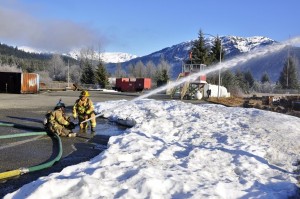
It was a golden opportunity for me as I got to play firefighter for a whole day.
Many little boys and girls dream of becoming a firefighter, and this is the first chance I’ve had to dress up as a fireman since running home to see afterschool reruns of Squad 51’s Gage and DeSoto.
Capital City Fire and Rescue Captain John Krebsbach says their day-long experience is designed to show local policy makers and the media how to operate an effective fire department in any community.
“The purpose is to demonstrate the need for more staffing. That’s the whole gist,” Krebsbach said. “There’s three main points that were trying to get out of this whole thing. That our jobs are time sensitive, labor intensive, and very technical.”
I’m at the Hagevig Fire Training Center in Juneau along with other invited participants.
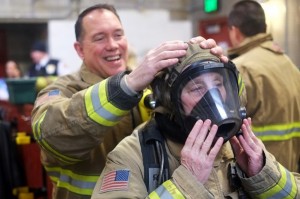
I get to wear or use all the usual firefighters tools : the bunker or turnout gear, boots, helmet, Nomex fire resistant hood, and the SCBA or self-contained breathing apparatus. Those are the air packs used by firefighters when they enter a smoke-filled structure.
“Suck in, there you go!” advises CCF&R firefighter Erik Goldsberry as he helps me fit my mask and activate my SCBA. Goldsberry is my shadow: my partner, instructor, and guardian angel all rolled into one.
I’m now wearing another 60 pounds.
I’ve already climbed a truck ladder, operated a hose for defensive fire operations, used a chainsaw to ventilate a roof, and entered smoke filled rooms to douse fires or find victims. But it is this next exercise that is the most revealing.
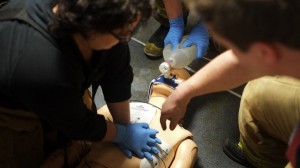
“So, Matt? I need you to start doing CPR on this guy,” says EMT Travis Larsen, coordinator of the medical call scenario.
Something is wrong with the victim. We don’t know anything about underlying health issues yet, but his heart has stopped. We need to get it pumping again before we can get him into an ambulance for the trip to the hospital.
“Like this, Matt,” says Goldsberry as he shows me the proper hand placement and technique for CPR.
Goldsberry and I are helping with initial care. He paces out a rhythm for me.
“It’s like this. One, and 2, and 3…”
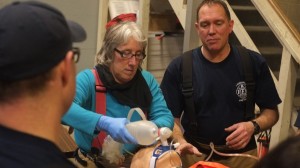
We’re not alone. Also responding in this scenario is a CBJ Assemblymember, a city employee, and a newspaper reporter and their shadows.
“You’re too slow, Matt,” Goldsberry says.
EMT Travis Larsen directs us to rotate positions, working with the heart monitor, administering medications, respirating the patient, and doing chest compressions.
“Going to charge it. Keep doing compressions,” Larsen calls out as the whine of a defibrilator rises higher and higher in tone. “
It’s my turn with the compressions.
“Keep going,” Goldsberry advises.
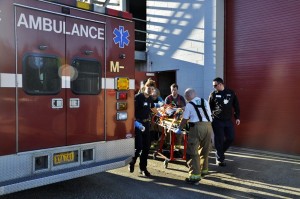
The victim is really a mechanical training dummy that provides feedback to the portable heart monitors.
“Everyone’s clear?!” asks Larsen.
“Clear!”
“Shock delivered. Back on CPR!” orders Larsen.
But I’m not going deep enough, I’ve lost count, and I have absolutely no rhythm.
“…19, 20, 21, 22, 23…” counts Goldsberry.
“He’s tired,” says Goldsberry when Larsen asks about the how many cycles have been completed.
The patient is eventually stabilized and we put him on a backboard to carry him out of the second-floor room.
“Lift with your feet,” advises Goldsberry.
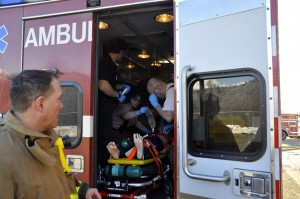
At 185 pounds, this patient may not be that heavy. But, still, it’s no wonder that firefighters frequently get injured on the job. Goldsberry says back injuries are at the top of the list.
“Imagine if this is a 350 pound man and how much harder that it’s going to be,” Larsen says. “Or, if he was in a bathroom?”
I get to step backward down the stairs, holding my end of backboard as high as I can.
“Hold him high, Matt!” Goldsberry says.
“You’re going to want to go higher and higher,” advises Joe Mishler, another firefighter shadow.
At the bottom of the stairs, we put the backboard on a gurney, wheel it out the door, and into the ambulance for the trip to the hospital.
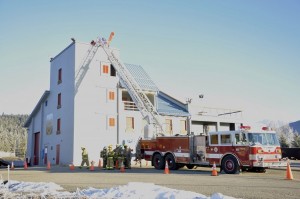
This is why you usually see a fire engine following an ambulance to a medical call in Juneau. CCF&R officials say the number of EMTs and firefighters is only half what they need for the various apparatus and vehicles. The captain and engineer may be the only ones at the scene of the fire until other crews arrive or volunteers are summoned. And ambulance crews? It’s now very clear why two EMTs are not enough.
On the way to the hospital, Larsen communicates with the hospital while us four students in the ambulance bumble and fumble with administering medications and air, or continuing compressions.
“Boom, boom, boom” jokes Larsen as he half-sings out a rhythm. “Dun, dun, dun… Staying Alive! Staying Alive!”
I’m back at it, standing up while pumping away.
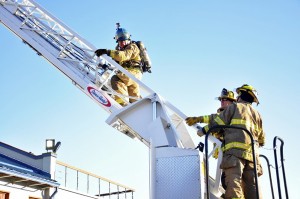
The ambulance driver lets us know about potholes and most turns.
“Left turn!”
“Left turn, alright” repeats Larsen.
But a sharp turn and I lose my balance, nearly falling completely on top of the patient.
Finally, we arrive at the virtual hospital and get the patient inside.
“You guys have any questions about anything in general?” asks Larsen.
“Is he still alive?” I ask, half-joking.

Condition of the patient may be a little unclear, but I know for sure that I just got my butt kicked.
I’m all hot, sweaty and exhausted. What I don’t know now is that I’ll be stiff and aching all over tomorrow.
Captain John Krebsbach says participants of earlier exercises in the Lower 48 had similar reactions.
“They’re usually eye opening,” Krebsback says. “They didn’t realize how involved the job actually is. It is a hard job. It’s physically demanding.”
So much for my childhood fantasy. Playing firefighter was a serious reality check. This is not a job anyone can just walk into. I just experienced – in a matter of hours – a taste of what the normal, entry-level firefighter goes through in a full year of training.
Matt Miller is a reporter at KTOO in Juneau.




